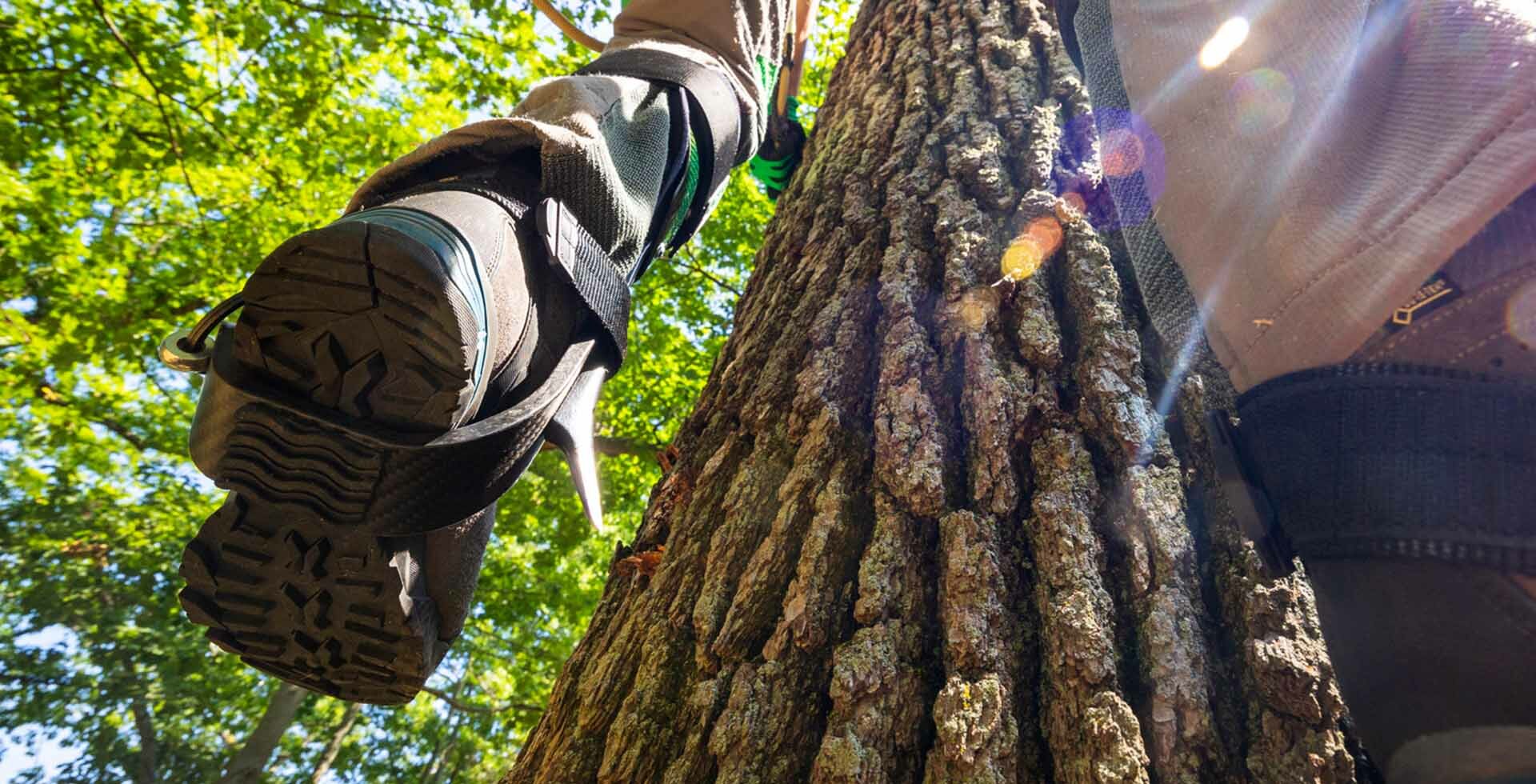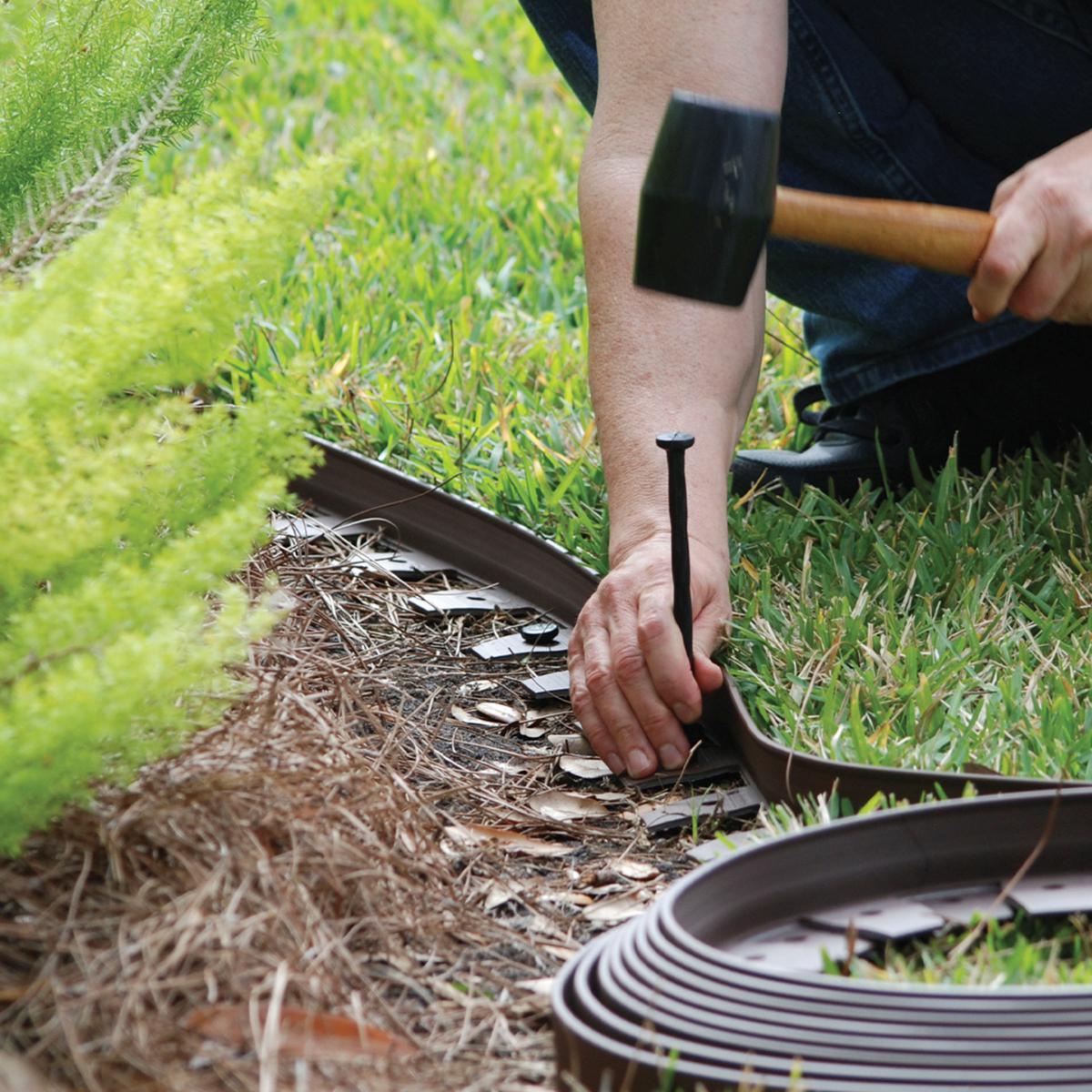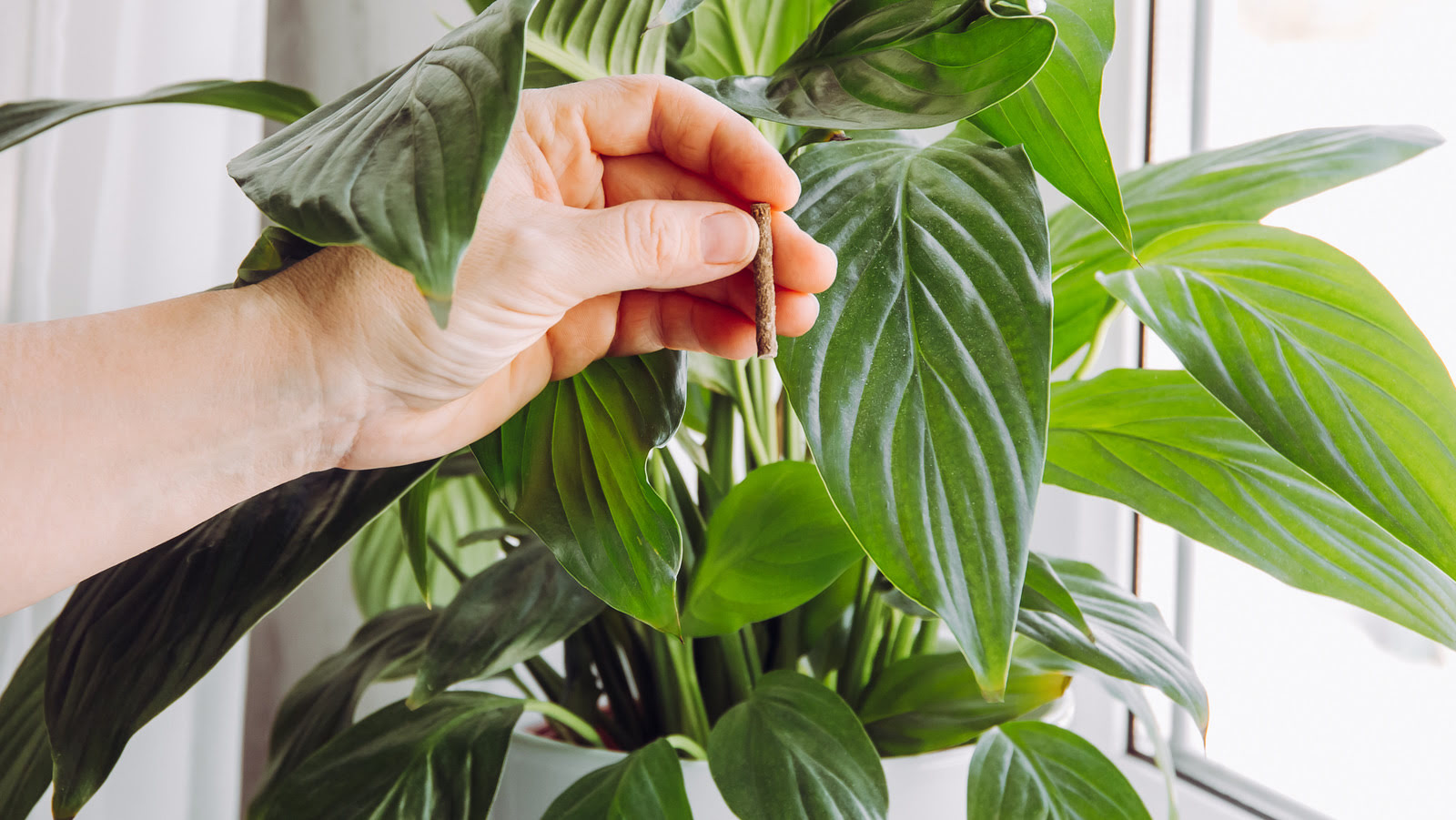Home>Gardening News and Trends>Latest News>How To Climb Trees With Spikes


Latest News
How To Climb Trees With Spikes
Published: November 1, 2023
Discover the latest news on how to safely climb trees with spikes, including tips and techniques to enhance your tree-climbing experience.
(Many of the links in this article redirect to a specific reviewed product. Your purchase of these products through affiliate links helps to generate commission for Chicagolandgardening.com, at no extra cost. Learn more)
Table of Contents
Introduction
Welcome to the thrilling world of tree climbing! Nothing can compare to the feeling of being high up in the canopy, surrounded by lush green leaves, and enjoying a panoramic view of nature. If you have ever dreamt of climbing trees like a professional, then tree climbing spikes are the perfect tool to help you achieve that dream.
Tree climbing spikes, also known as gaffs or spurs, are essential equipment used by arborists, tree surgeons, and even adventure enthusiasts to ascend and work on trees. These specialized spikes are strapped to the climber’s boots, allowing them to safely scale the tree trunk.
However, it’s important to note that tree climbing spikes should only be used for tasks like pruning, trimming, or removing trees, and not for casual tree climbing. This is because the spikes can cause damage to the tree’s bark and create unnecessary wounds. It’s crucial to always prioritize the health and safety of the tree when using climbing spikes.
In this comprehensive guide, we will walk you through everything you need to know about tree climbing spikes. From choosing the right spikes to safely putting them on and climbing trees, we’ve got you covered. We’ll also provide some useful tips and tricks to make your tree climbing experience unforgettable.
But before we delve into the exciting world of tree climbing, let’s talk about the importance of safety. Tree climbing can be a dangerous activity, so it’s essential to take every precaution to protect yourself and ensure a safe climb. Remember, safety should always be your top priority.
What Are Tree Climbing Spikes?
Tree climbing spikes, also known as gaffs or spurs, are specialized metal tools designed to assist climbers in scaling trees. They consist of a metal shank with sharp points or spikes, which are strapped to the climber’s boots. The spikes provide traction and grip, allowing climbers to ascend trees efficiently and safely.
Tree climbing spikes have two main components: the shank and the spur. The shank is the long, curved part of the spike that attaches to the climber’s boot. It is usually made of strong, durable steel that can withstand the pressures of climbing. The spur, on the other hand, is the part of the spike that penetrates the tree bark and provides stability for the climber.
There are two types of tree climbing spikes: tree climbing spikes with long gaffs and tree climbing spikes with short gaffs. Tree climbing spikes with long gaffs are typically used for tree work, such as pruning or removing branches. The long gaffs provide a deeper and more secure hold on the tree trunk, allowing climbers to maneuver easily. On the other hand, tree climbing spikes with short gaffs are mainly used for climbing trees for recreational purposes. These spikes offer a shorter and less invasive grip to prevent unnecessary damage to the tree.
It’s important to note that tree climbing spikes should only be used on trees with hard, robust bark, such as oak, pine, or maple trees. Climbing spikes should not be used on trees with thin or delicate bark, as they can cause significant harm. Furthermore, climbers should avoid using spikes on trees that are diseased, decayed, or in poor health, as this can cause further damage and compromise the tree’s stability.
Tree climbing spikes are valuable tools for arborists, tree surgeons, and other professionals who work with trees. They provide a secure and efficient method of accessing tree canopies for various tasks. However, they require proper training and experience to ensure safe and responsible use. Aspiring climbers should seek guidance from trained professionals or join tree climbing courses to learn the correct techniques and safety protocols for using tree climbing spikes.
Choosing the Right Tree Climbing Spikes
When it comes to selecting the right tree climbing spikes, there are several factors to consider. The type of climbing you plan to do, the tree species you’ll be climbing, and your level of experience all play a role in determining the most suitable spikes for your needs. Here are some key considerations to keep in mind:
1. Purpose: Determine the purpose of your tree climbing activities. Are you climbing for recreational purposes or for professional tree work? Different spikes are designed for different tasks. If you’re a professional arborist, you’ll need spikes with long gaffs that provide a secure grip for tasks like pruning or removing branches. For recreational climbers, shorter gaffs offer a lighter and less invasive option.
2. Tree species: Consider the type of trees you’ll be climbing. Some spikes are better suited for certain tree species. As mentioned earlier, avoid using spikes on trees with delicate bark or those that are in poor health. For hardwood trees, longer gaffs are ideal, while shorter gaffs work well for softer bark trees.
3. Comfort and fit: Comfort is key when it comes to tree climbing spikes. Look for spikes that have adjustable straps and padding on the shank for added comfort. Proper fit is also crucial for safety and stability. Ensure that the spikes fit securely on your boots and provide a snug fit without constriction.
4. Durability: Invest in spikes made from high-quality materials that can withstand the rigors of tree climbing. Quality steel is often used for the shank to ensure strength and durability. Additionally, check the durability of the straps and buckles, as they play a critical role in securing the spikes to your boots.
5. Training and experience: Consider your level of training and experience with tree climbing. If you’re a beginner, it’s advisable to opt for spikes with shorter gaffs, as they offer more forgiving climbing surfaces. As you gain more experience and confidence, you can transition to spikes with longer gaffs for more advanced climbing techniques.
It’s important to consult with experts or experienced climbers to get recommendations on the best tree climbing spikes for your specific needs. They can provide valuable insights and guidance based on their own experiences and expertise.
Remember, choosing the right tree climbing spikes is crucial for ensuring your safety, the health of the tree you’re climbing, and the success of your climbing endeavors. Take the time to research and select the spikes that best align with your unique requirements and climbing goals.
Safety Precautions Before Climbing
Tree climbing, while exhilarating, can also be a risky activity. It’s essential to prioritize safety and take necessary precautions before embarking on a climbing adventure. Here are some key safety measures to consider:
1. Proper gear: Ensure that you have the appropriate gear for tree climbing. This includes not only tree climbing spikes but also a sturdy climbing harness, a helmet, gloves, and eye protection. The climbing harness should fit properly and be adjusted according to your body size to provide maximum support and stability.
2. Training and guidance: Seek proper training from experienced climbers or certified instructors before attempting to climb trees. They can teach you essential techniques, safety procedures, and how to properly use your climbing spikes. It’s important to gain hands-on experience under the supervision of an experienced climber to ensure you understand the nuances of safe tree climbing.
3. Environmental assessment: Before climbing, assess the environment around the tree. Look for any potential hazards such as dead branches, loose bark, or unstable limbs that could pose a safety risk. Be cautious of hazards like electrical wires or nearby obstacles that could interfere with your climb.
4. Weather conditions: Pay attention to weather conditions before your climb. Avoid climbing during thunderstorms, heavy winds, or extreme weather conditions that could compromise your safety. Wet or icy surfaces can make the climb more hazardous, so it’s best to wait for suitable weather conditions.
5. Communication and support: Let someone know about your climbing plans and when you expect to return. This can be a friend, family member, or fellow climber who can provide assistance or seek help if needed. Having a support system in place ensures that someone is aware of your whereabouts in case of an emergency.
6. Physical preparedness: Ensure that you are physically fit and in good health before attempting tree climbing. Climbing trees requires strength, agility, and endurance. Regular exercise and a healthy lifestyle can help build the necessary physical capabilities for safe climbing.
7. Mindfulness and focus: Maintain a sharp focus and a clear, alert mind while climbing. Stay present in the moment, avoiding distractions or rushing through the climb. Mindful climbing improves your awareness of potential risks and helps you make sound decisions to ensure your safety.
Remember, safety should always be the top priority when engaging in any outdoor activity, including tree climbing. By following these safety precautions and taking the necessary steps to prepare yourself physically and mentally, you can enjoy a safe and thrilling tree climbing experience.
How to Put On Tree Climbing Spikes
Putting on tree climbing spikes correctly is essential for ensuring a secure and comfortable climb. Here are step-by-step instructions on how to properly attach tree climbing spikes to your boots:
1. Prepare your gear: Gather all the necessary equipment, including your tree climbing spikes, boots, and any additional accessories such as straps or padding. Ensure that your boots are clean and in good condition for optimal performance.
2. Positioning the spikes: Start by locating the right position on your boots for attaching the spikes. Most spikes have an adjustable strap that wraps around the shank of the spike to secure it to your boot. The spikes should be positioned on the inside of your foot, aligned with the ball of your foot and the arch.
3. Secure the straps: Wrap the straps tightly around your boots and secure them in place. Adjust the straps to ensure a snug and comfortable fit. Make sure the spikes are positioned firmly on your boots, without any loose or dangling parts that could impede your movement or cause a safety hazard.
4. Test the spikes: Before starting your climb, take a few test steps to ensure that the spikes are securely attached and properly aligned. Walk on a flat surface to familiarize yourself with the sensation of having the spikes on your boots. If you notice any discomfort or instability, adjust the straps accordingly.
5. Practice walking and balance: Once you’re comfortable with the spikes on your boots, practice walking and balancing on various terrains. This allows you to get accustomed to the added weight and adapt your stride to maintain stability. Ensure that the spikes do not hinder your natural movement and allow for a smooth and controlled walk.
6. Familiarize yourself with climbing techniques: Take the time to learn and practice proper climbing techniques, such as using your legs instead of relying solely on your arms for support. Mastering these techniques not only ensures a safer climb but also reduces strain on your upper body and improves overall climbing efficiency.
7. Regular maintenance: After each climb, inspect your spikes for any signs of damage or wear. Replace worn-out straps or padding to maintain optimal performance. Clean your spikes and boots to remove any debris or dirt that could impact their functionality and longevity.
It’s important to note that putting on tree climbing spikes should be done with caution and proper guidance. If you’re a beginner or unfamiliar with the process, seek advice from experienced climbers or participate in tree climbing courses to learn the correct techniques and ensure your safety.
Remember to always prioritize your safety, take the time to properly put on and adjust your tree climbing spikes, and familiarize yourself with their proper usage before venturing into the trees.
Techniques for Climbing Trees with Spikes
Climbing trees with spikes requires specific techniques to ensure a safe and efficient ascent. Here are some important techniques to keep in mind when using tree climbing spikes:
1. Using your legs: Tree climbing spikes are designed to provide stability and traction, primarily through the use of your legs. Instead of relying heavily on your arms, push off with your legs to propel yourself up the tree trunk. This technique conserves energy and reduces strain on your upper body.
2. Three-point contact: Maintain three-point contact with the tree at all times for enhanced stability. This means having both feet secured with spikes and one hand holding onto a sturdy branch or trunk. Always ensure that at least three points of contact are maintained before moving your other hand or foot to a new position.
3. Choosing the right route: Select a suitable path up the tree based on the placement of branches, strong limbs, or natural features like knots or ridges. Look for secure holds and sturdy branches to support your weight. Plan your route strategically to minimize unnecessary movement and potential risks.
4. Weight shifting: Master the technique of shifting your weight while climbing. This involves transferring your weight from one foot to another as you ascend, allowing the spikes to dig into the tree bark securely. Practice maintaining a balanced center of gravity by distributing your weight evenly between your feet.
5. Working with gravity: Utilize the force of gravity to your advantage while climbing. Lean back slightly to maintain balance and allow gravity to assist in positioning your spikes for the next step. This technique helps reduce the strain on your legs and allows for smoother climbing movements.
6. Resting positions: Take frequent breaks to rest and catch your breath during the climb. Look for secure and comfortable spots, such as sturdy branches or tree forks, where you can rest and regain your strength. Avoid placing unnecessary strain on your legs by utilizing these resting positions strategically.
7. Smooth and controlled movements: Keep your movements smooth and controlled to maintain stability and avoid sudden jerks or rapid shifts. Take your time and focus on maintaining a steady pace rather than rushing through the climb. This approach ensures better control over your body and reduces the risk of accidents.
8. Constant vigilance: Stay alert and continuously assess your surroundings while climbing. Be aware of potential hazards, such as loose branches or unstable limbs. Regularly check your climbing spikes to ensure they remain securely attached and functioning properly.
Remember, tree climbing with spikes requires practice and experience to develop the necessary skills. Start with small, manageable climbs and gradually progress to more challenging trees as you gain confidence and proficiency. Always prioritize safety and never attempt climbs that are beyond your skill level.
By following these techniques, maintaining a focused mindset, and respecting the tree and its environment, you can enjoy a safe and rewarding tree climbing experience.
Tree Climbing Tips and Tricks
Tree climbing is an exhilarating activity that allows you to connect with nature and experience the world from a unique perspective. To enhance your tree climbing adventures, here are some valuable tips and tricks:
1. Start with the right tree: Choose trees that are strong, healthy, and well-suited for climbing. Look for trees with sturdy branches and robust trunks that can support your weight. Avoid trees with signs of disease, decay, or unstable structural integrity.
2. Plan your route: Before you start climbing, carefully plan your route up the tree. Evaluate the positions of branches and natural features that can support your ascent. Take note of potential obstacles or hazards that you may encounter along the way.
3. Warm up and stretch: Prior to climbing, perform some warm-up exercises and stretching to prepare your muscles and increase flexibility. This helps prevent injuries and allows for smoother and more controlled movements while climbing.
4. Use the right gear: Invest in high-quality tree climbing equipment, including spikes, a climbing harness, a helmet, gloves, and eye protection. Ensuring that you have reliable and well-maintained gear is vital for your safety and enjoyment during the climb.
5. Learn from experienced climbers: Seek advice and guidance from experienced climbers. Join tree climbing groups or workshops to learn valuable techniques and gain insights from those who have mastered the art of tree climbing. Their wisdom and experience can help you improve your skills and make your climbs more enjoyable.
6. Practice tree identification: Familiarize yourself with different tree species and their characteristics. This knowledge will enable you to choose the right trees for climbing and identify any potential risks or challenges associated with specific species.
7. Follow Leave No Trace principles: Respect the environment and minimize your impact on the tree and its surroundings. Avoid damaging branches or breaking off limbs, as this can harm the tree and disrupt its ecosystem. Leave the tree as you found it, ensuring its continued health and preservation.
8. Stay hydrated and take breaks: Climbing trees can be physically demanding, so remember to stay hydrated by drinking plenty of water. Take regular breaks to rest, rehydrate, and enjoy the view. This allows your muscles to recover and helps maintain your energy levels throughout the climb.
9. Capture the moment: Bring a camera or a smartphone with you to capture memorable moments during your tree climbs. Preserve the beauty and uniqueness of each climb, and share your experiences with others who appreciate the wonders of tree climbing.
10. Keep learning and expanding: Never stop learning and expanding your tree climbing skills. Seek new challenges, explore different locations, and continuously strive to improve your techniques. The world of tree climbing is vast and diverse, offering endless opportunities for growth and discovery.
Remember, safety should always be your top priority while climbing trees. Follow the necessary precautions, plan your climbs carefully, and never take unnecessary risks. With practice, experience, and a passion for adventure, you can embark on incredible tree climbing journeys and create lasting memories.
Removing Tree Climbing Spikes
After a successful tree climbing adventure, it’s important to know how to properly remove your tree climbing spikes. Here are the steps to safely remove your spikes:
1. Find a stable position: Look for a secure spot on the tree where you can comfortably rest and maintain balance while removing the spikes. This can be a sturdy branch or a tree fork that can support your weight.
2. Secure yourself: Hold on to a secure limb or branch with one hand to ensure stability and maintain three-point contact with the tree while removing your spikes. This helps prevent any accidental slips or falls.
3. Loosen the straps: Start by loosening the straps on your climbing spikes. Depending on the design, this may involve unfastening buckles, loosening straps, or releasing any other securing mechanisms. Take your time to ensure that the straps are adequately loosened before removing the spikes.
4. Gradually remove the spikes: After loosening the straps, gently lift your foot that has the spike attached while maintaining your grip on the branch or limb. Slowly pull the spike out of the tree bark, taking care not to rush or apply excessive force. Repeat the process for the other foot.
5. Inspect your spikes: Once the spikes are removed, carefully inspect them for any signs of damage or wear. Check for any loose screws, bent gaffs, or other issues that may affect their performance. Damaged spikes should be replaced or repaired before the next climb.
6. Clean your spikes: After inspection, take the time to clean your spikes to remove any dirt or debris that may have accumulated during the climb. Use a soft brush or cloth to gently wipe down the spikes, paying attention to the gaffs and the straps. This helps maintain their functionality and prolong their lifespan.
7. Store your spikes properly: Ensure that your spikes are stored in a dry, cool place away from direct sunlight. This helps prevent any rusting or potential damage to the spikes. Also, make sure the straps are neatly folded or secured to prevent entanglement.
8. Reflect on the climb: Take a moment to reflect on your tree climbing experience. Appreciate the beauty of nature, the thrill of climbing, and the memories you’ve created during your adventure. Share your experience with others who have a passion for tree climbing or outdoor activities.
9. Continued learning: Remember, tree climbing is an ongoing learning process. Reflect on your climb, identify areas for improvement, and seek opportunities to enhance your skills. Regular practice, seeking advice from experienced climbers, and participating in training sessions can help you become a better climber.
By following these steps, you can safely remove your tree climbing spikes and ensure that they are ready for your next adventure. Remember, proper care and maintenance of your spikes are essential for optimal performance and safety during future climbs.
Conclusion
Tree climbing with spikes is a thrilling and rewarding activity that allows you to appreciate nature from a unique perspective. By following the right techniques, using proper gear, prioritizing safety, and respecting the environment, tree climbing can be a safe and enjoyable experience.
Choosing the right tree climbing spikes, putting them on correctly, and practicing the appropriate climbing techniques are crucial for a successful climb. Ensure that you have received proper training and guidance from experienced climbers to develop the necessary skills and knowledge for safe tree climbing.
Throughout your tree climbing journey, remember to prioritize safety at all times. Take necessary precautions, assess your surroundings, and stay vigilant. Regularly inspect and maintain your gear to ensure it is in good working condition. Respect the trees you climb, follow Leave No Trace principles, and minimize your impact on the environment.
Continue to learn and grow as a tree climber. Seek out new challenges, explore different tree species and locations, and share your experiences with others who share your passion. Tree climbing is an ever-evolving adventure, offering endless opportunities for exploration and personal growth.
So, strap on your climbing spikes, choose the right tree, and embark on a journey filled with excitement, beauty, and a deep connection with nature. Let the trees be your guide as you ascend to new heights and experience the world in a way few others have. Happy climbing!









